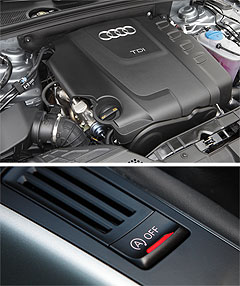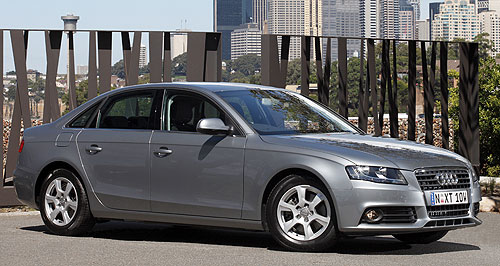New models - Audi - A4 - 2.0 TDIe sedanAudi’s eco A4 arrivesE change: Audi's A4 2.0 TDI e sips just 4.8 litres per 100km. Audi ups the teetotaller ante in the luxury sedan class with the A4 TDI e9 Mar 2010 AUDI is supplanting one ‘e’ branded high-economy model for another in the guise of the B8 A4 2.0 TDI e. On sale now from $49,900, the manual-only four-door sedan usurps the short-lived A3 1.9 TDI e that was released in Australia in early 2008. It introduces Audi’s ‘Start-Stop’ system to help achieve a class-leading 4.8 litres per 100 kilometres, while its carbon dioxide emissions rating comes in at an also segment-blazing 124 grams per kilometre. The Ingolstadt newcomer is also the first diesel-powered A4 not to breach the $50,000 barrier since the TDI engine was launched in the preceding B7 range in late 2005. In contrast the old A3 1.9 TDI e – which sold for $38,900 – wooed the environmentally minded with just 4.5L/100km and 119g/km. No rival currently comes close. The $58,300 BMW E90 320d and $61,400 Mercedes-Benz W204 C220 CDI BlueEFFICIENCY manage 5.4L/100km and 144g/km, and 6.3L/100km and 164g/km, respectively.  These figures, however, are for the automatic versions the $52,900 A4 2.0 TDI Multitronic equivalent fits somewhere in between its compatriots at 5.8L/100km and 154g/km. These figures, however, are for the automatic versions the $52,900 A4 2.0 TDI Multitronic equivalent fits somewhere in between its compatriots at 5.8L/100km and 154g/km.Under the designer bonnet is an EU5 emissions-compliant 1968cc 2.0-litre common-rail direct-injection four-cylinder turbo-diesel engine developing 100kW of power at 4200rpm and 320Nm of torque from 1750rpm to 2500rpm. Driving the front wheels via a conventional six-speed manual gearbox, the 1475kg A4 2.0 TDI e hits 100km/h from standstill in 9.5 seconds (130kW/350Nm 320d: 8.0s 125kW/400Nm C220 CDI: 8.4s), on its way to a 215km/h top speed. Of more interest to prospective purchasers, however, is the effect the idle-stop technology has on the A4 2.0 TDI e’s efficiency ratings – Audi says it saves up to 1.5L/100km in city traffic and 0.2L/100km on the highway cycle, for a 5g/km cut. “As soon as the vehicle comes to a stop, the shift lever is in neutral, and the driver removes his or her foot from the clutch pedal, the system turns the engine off. The engine then turns back on as soon as the clutch pedal is depressed,” Audi says. “The start-stop system functions extremely quietly, smoothly, and quickly. While the driver is stepping on the clutch pedal to shift into first gear, the engine instantaneously returns to its idle speed.” Also putting the efficiency in ‘e’ (to the tune of 30 per cent all told) is a five per cent higher final drive ratio, while the engine management system has been altered, the driver has an up-shift indicator in the instrumentation pack to signal when it’s best to change gears, and the standard trip computer provides “fuel saving hints” while driving in real time. Moreover, Audi fits a braking energy recovery set-up that uses a modified alternator to convert surplus kinetic energy to electrical energy during braking by temporarily storing it in the car’s battery when the A4 2.0 TDI e resumes acceleration, the battery releases this stored energy into the vehicle’s electrical hub, thus cutting down the alternator’s load on the engine and so consequently saving diesel. Finally, improved aerodynamics mean more fuel efficiencies thanks to additional ‘drag’ inhibitors in the shape of an underbody trim panel, partially enclosed radiator grille, and a 20mm lower ride height due to the fitment of the regular A4’s ‘sport chassis’. The drag co-efficiency is a handy 0.26Cd. We can expect to see other Audi e models in the future, but for now the A4 2.0 TDI e is a lone wolf. In Europe, there is also an A6 version returning 5.3L/100km while the new-generation A8 will offer a 3.0 V6 TDI that’s capable of returning just 6.0L/100km. The latter is an unlikely starter for Australia, though, as it is a front-drive only model and Audi has stated that the A8 will only be imported in quattro all-wheel drive format for the time being. But expect the 3.0 TDI quattro version anyway. The LCT Luxury Car Tax-exempt A4 2.0 TDI e is the 22nd model Audi sells in Australia with a sub-7.0L/100km average combined fuel consumption figure, as the firm attempts to cut overall consumption in all its vehicles by 20 per cent by 2012. Audi’s marketing manager Immo Buschmann said that the company is committed to improving the efficiency of its internal combustion engines as the brand also moves into electric power. “While Audi has a clear focus on fully-electric vehicles for future sustainable motoring, our mid-term philosophy is to continue reducing the consumption of our excellent combustion engines. These engines become more efficient with every new generation, and there’s still more room for improvement in the future,” Mr Buschmann said. “Our TDI engines in particular are strong sellers in Australia. Audi is very committed to TDI technology globally, and particularly for Australia.”  Read more9th of March 2010  Audi starts idle-stopAudi idle-stop arrives in selected A4 and A5 models but with manual-only for nowAll new models Alfa Romeo Alfa Romeo Abarth Abarth Audi Audi Aston Martin Aston Martin BMW BMW Bentley Bentley Chrysler Chrysler Chevrolet Chevrolet Dodge Dodge Citroen Citroen Ferrari Ferrari DS DS Ford Ford Fiat Fiat FPV FPV Foton Foton Haval Haval Great Wall Great Wall Honda Honda Holden Holden Hyundai Hyundai HSV HSV Isuzu Isuzu Infiniti Infiniti Jeep Jeep Jaguar Jaguar Lamborghini Lamborghini Kia Kia Lexus Lexus Land Rover Land Rover Mazda Mazda Maserati Maserati Mercedes-Benz Mercedes-Benz McLaren McLaren Mini Mini Nissan Nissan Mitsubishi Mitsubishi Peugeot Peugeot Opel Opel Proton Proton Porsche Porsche Renault Renault Ram Ram Saab Saab Rolls-Royce Rolls-Royce Smart Smart Skoda Skoda Subaru Subaru SsangYong SsangYong Tesla Tesla Suzuki Suzuki Toyota Toyota Volvo VolvoA4 pricing
Motor industry news |
|
















Facebook Twitter Instagram